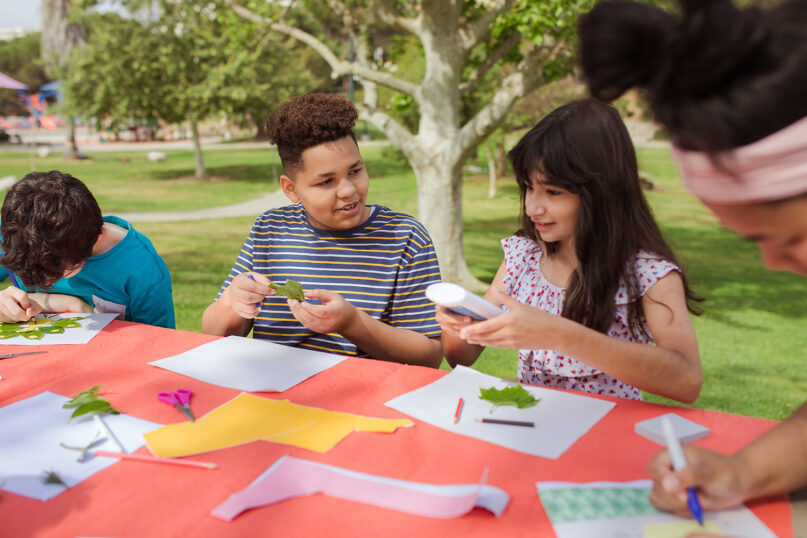(RNS) — Last month I came across this news story about the Church of Jesus Christ of Latter-day Saints holding a “Primary day camp modeled after FSY.”
In essence, the story reported about a stake in Utah that organized two single-day trial runs of a Saturday camp for children ages 8 to 11.
It’s filled with rah-rah quotes from adults about how terrific day camp experiences can be for children and youth, and surprised-sounding comments from children who seemed a bit astonished that the event was actually fun. One 9-year-old who called it “amazing” was quoted as saying, “There’s a lot of stuff to do, and I haven’t been getting bored.”
There are a few hints in the story that this activity wasn’t just a one-off example of a single stake in Utah that went rogue. The piece’s tagline says, “youth, single adults and others volunteer at stake day camp for Primary kids to model how other wards and stakes could integrate Children and Youth program.” The “to model” part indicates that this concept may be coming soon to a Primary near you, as does the fact that a local initiative was covered in the Church’s international news publication in the first place.
The article’s last word goes to Bonnie Cordon, the global president of the Young Women organization. She lauded the idea that the Primary day camp was patterned after the Church’s successful multi-day FSY gatherings for teens, and that its activities were just that — activities — rather than a more passive model where children are expected to sit and listen.
This suggests to me that what happened in Utah may be a pilot program that’s going to be replicated elsewhere, possibly on a larger scale. President Cordon mentions that part of the “secret sauce” of FSY is that it’s a multi-day event, so perhaps that’s where this program will be going. I wonder if we will see a weeklong summer experience similar to Protestants’ venerable Vacation Bible School programs, where kids spend five half-days learning about Jesus through songs, stories, crafts and games.
I hope so. There are few better uses of our time and money in the Church than ramping up our investment in children and youth. In the U.S. we have begun experiencing the early stages of a retention crisis, with more individuals — and whole families — leaving the Church. And, given our falling birth rates and declining conversions, most of those people are not being replaced.
Privately in my conversations with people in leadership or who work for the Church, I hear how deeply concerned they are with this issue and how hard they’re working to rectify the problem. They are fully aware of the situation. But publicly, the Church appears determined to either ignore the problem or claim it does not exist.
Take, for example, a recent “Deseret News” article that chronicled a surge in young adults serving missions compared to the previous year. A rebounding missionary program is wonderful news. However, the article failed to mention that the increase to 68,000 missionaries is only slightly above the 2019 pre-pandemic figure of 67,000, so it’s not an especially dramatic upswell. That’s particularly true if the numbers are reflecting a temporary “double cohort” phenomenon in which missionaries who would have served in 2020 and 2021 but chose to postpone their missions are serving now alongside the ones who would have gone in 2022 and 2023 anyway.
Given the realities of ebbing retention, my feeling is that the more we can do to get children and youth excited about the Church as a safe and happy place that meets their needs, the better.
For this, we might mine some elements from our own relatively recent history. Primary used to be a good deal more fun than it is now. It was held on a weekday after school, and it wasn’t only or even predominantly about indoctrination. Many of the songs were silly and purely secular. We still have a couple of those in rotation, most famously “Popcorn Popping” and “Once There Was a Snowman,” but the others have been replaced by Songs That Teach a Lesson.
And I get it. I do: When the Church moved to a three-hour Sunday block in 1980 and moved Primary from the middle of the week to the Sabbath, its focus needed to change accordingly. But many things were lost in that process, not the least of which were that Primary and church could be a great time, a gathering to which you might want to invite your non-member friends.
If the Church is rediscovering the wisdom of that model, drawing from its own history and from the Protestants’ VBS example, I say hallelujah. (Now the trick will be to implement that program without placing undue burdens on volunteers, mostly women, since the whole infrastructure of weekday Primary once depended on unpaid female labor.)
Related content:
One in four US Mormons has thought about leaving the LDS Church, study shows
How religious are GenZ Mormons in the US? The results are mixed.






